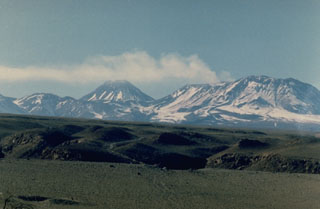Report on Lascar (Chile) — January 1994
Bulletin of the Global Volcanism Network, vol. 19, no. 1 (January 1994)
Managing Editor: Richard Wunderman.
Lascar (Chile) Short eruption in December 1993 sends plume 8-10 km high
Please cite this report as:
Global Volcanism Program, 1994. Report on Lascar (Chile) (Wunderman, R., ed.). Bulletin of the Global Volcanism Network, 19:1. Smithsonian Institution. https://doi.org/10.5479/si.GVP.BGVN199401-355100
Lascar
Chile
23.37°S, 67.73°W; summit elev. 5592 m
All times are local (unless otherwise noted)
"At 0835 on 17 December 1993, Lascar had a new short-lived explosive eruption. Ibar Torrejón, the teacher in Talabre (17 km WNW) who maintains a log of Lascar's activity, reported that a strong explosion was followed by the rise of a dark gray plume up to 8-10 km above rim of the active crater. The eruption was accompanied by seismic activity felt in Talabre with an intensity of MM 3. Another small explosion was recorded at 0930, with a dark plume rising 2 km. Although the dark coloration of the plume suggests significant ash content, no ashfall was recorded in the few populated areas E or SE of Lascar, where prevailing winds normally transport the plumes (El Laco, 60 km SSE; Catua, 80 km SE; and Salta, 285 km SE). There were no witnesses closer to the S or E flanks of the volcano at the moment of the eruption. Also, no ballistic blocks were observed, suggesting that it was a small, mainly phreatic, eruption. Since then Lascar has returned to normal fumarolic activity, with columns rising 200-400 m above the active crater rim.
"[The domes] progressive collapse since May 1993 suggested that it was following the pattern shown since 1985, so local authorities were warned in November of the possibility of a new eruption within the next months. Local authorities have again been warned that similar or larger eruptions can take place in the near future."
Geological Summary. Láscar is the most active volcano of the northern Chilean Andes. The andesitic-to-dacitic stratovolcano contains six overlapping summit craters. Prominent lava flows descend its NW flanks. An older, higher stratovolcano 5 km E, Volcán Aguas Calientes, displays a well-developed summit crater and a probable Holocene lava flow near its summit (de Silva and Francis, 1991). Láscar consists of two major edifices; activity began at the eastern volcano and then shifted to the western cone. The largest eruption took place about 26,500 years ago, and following the eruption of the Tumbres scoria flow about 9000 years ago, activity shifted back to the eastern edifice, where three overlapping craters were formed. Frequent small-to-moderate explosive eruptions have been recorded since the mid-19th century, along with periodic larger eruptions that produced ashfall hundreds of kilometers away. The largest historical eruption took place in 1993, producing pyroclastic flows to 8.5 km NW of the summit and ashfall in Buenos Aires.
Information Contacts: M. Gardeweg, SERNAGEOMIN, Santiago.

